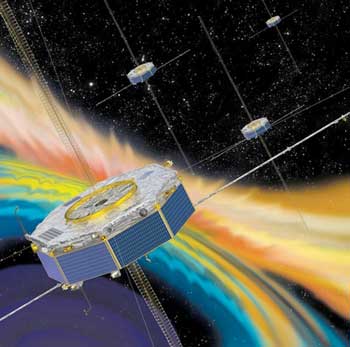| Feb 14, 2019 |
Spacecraft measurements reveal mechanism of solar wind heating
|
|
(Nanowerk News) Queen Mary University of London has led a study which describes the first direct measurement of how energy is transferred from the chaotic electromagnetic fields in space to the particles that make up the solar wind, leading to the heating of interplanetary space.
|
|
The study, published in Nature Communications ("Evidence for electron Landau damping in space plasma turbulence") and carried out with University of Arizona and the University of Iowa, shows that a process known as Landau damping is responsible for transferring energy from the electromagnetic plasma turbulence in space to electrons in the solar wind, causing their energisation.
|
 |
| This is an illustration of the MMS spacecraft measuring the solar wind plasma in the interaction region with the Earth's magnetic field. (Image: NASA)
|
|
This process, named after the Nobel-prize winning physicist Lev Landau (1908-1968), occurs when a wave travels through a plasma and the plasma particles that are travelling at a similar speed absorb this energy, leading to a reduction of energy (damping) of the wave.
|
|
Although this process had been measured in some simple situations previously, it was not known whether it would still operate in the highly turbulent and complex plasmas occurring naturally in space, or whether there would be a different process entirely.
|
|
All across the universe, matter is in an energised plasma state at far higher temperatures than expected. For example, the solar corona is hundreds of times hotter than the surface of the Sun, a mystery which scientists are still trying to understand.
|
|
It is also vital to understand the heating of many other astrophysical plasmas, such as the interstellar medium and the disks of plasma surrounding black holes, in order to explain some of the extreme behaviour displayed in these environments.
|
|
Being able to make direct measurements of the plasma energisation mechanisms in action in the solar wind (as shown in this paper for the first time) will help scientists to understand numerous open questions, such as these, about the universe.
|
|
The researchers discovered this using new high-resolution measurements from NASA's Magnetospheric Multi-Scale (MMS) spacecraft (recently launched in 2015), together with a newly-developed data analysis technique (the field-particle correlation technique).
|
|
The solar wind is the stream of charged particles (i.e., plasma) that comes from the Sun and fills our entire solar system, and the MMS spacecraft are located in the solar wind measuring the fields and particles within it as it streams past.
|
|
Lead author Dr Christopher Chen, from Queen Mary University of London, said: "Plasma is by far the most abundant form of visible matter in the universe, and is often in a highly dynamic and apparently chaotic state known as turbulence. This turbulence transfers energy to the particles in the plasma leading to heating and energisation, making turbulence and the associated heating very widespread phenomena in nature.
|
|
"In this study, we made the first direct measurement of the processes involved in turbulent heating in a naturally occurring astrophysical plasma. We also verified the new analysis technique as a tool that can be used to probe plasma energisation and that can be used in a range of follow-up studies on different aspects of plasma behaviour."
|
|
University of Iowa's Professor Greg Howes, who co-devised this new analysis technique, said: "In the process of Landau damping, the electric field associated with waves moving through the plasma can accelerate electrons moving with just the right speed along with the wave, analogous to a surfer catching a wave. This first successful observational application of the field-particle correlation technique demonstrates its promise to answer long-standing, fundamental questions about the behavior and evolution of space plasmas, such as the heating of the solar corona."
|
|
This paper also paves the way for the technique to be used on future missions to other areas of the solar system, such as the NASA Parker Solar Probe (launched in 2018) which is beginning to explore the solar corona and plasma environment near the Sun for the first time.
|

